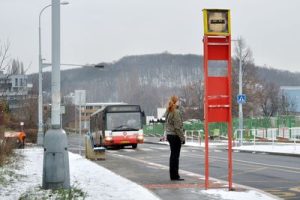Request stops
Passengers do not have to carefully monitor the arrival of a bus or tram at a “request” stop. At this time, they don’t have to give a hand signal (“waving”). This method works successfully in the surrounding European countries and other integrated systems in the Czech Republic and brings an increase in traffic flow and speed, as well as improved thermal comfort in public transport vehicles (especially in the winter months).
Practical advice on how to behave at “request” stops
I want to board:
- Buses, Trams
- I will take a position on the platform so that I can be seen by the driver in time (I don’t have to wave at an oncoming bus or tram), the driver must stop even if another public transport vehicle has already stopped at the stop and the passenger could be overlooked.
- Trains
- I will take a position on the platform so that I can be seen by the train driver in time and give the driver a clear signal at the right time (eg by raising my hand).

I want get off:
- Buses
- I press the “sign to the driver” button (usually located on the holding bars) or the door control button early enough for the driver to stop safely (indicated by an audible signal before each “request” stop, if that the reporting of stops does not work for some reason, the driver is obliged to stop at such a stop always).
- Trams
- I press the door control button (green button located on the door, on the holding bars or at places intended for the transport of wheelchairs and prams) enough for the driver to stop safely (indicated by an audible signal before each “sign” stop, if that the reporting of stops does not work for some reason, the driver is obliged to stop at such a stop always).
- Vehicles without these buttons must always stop at “request” stops.
- Trains
- I press the door control button (green button located on the door, on the holding bars or at places intended for the transport of wheelchairs and prams) enough for the driver to stop safely (indicated by an audible signal before each “sign” stop, if that the reporting of stops does not work for some reason, the driver is obliged to stop at such a stop always).
- Alternatively, I will respond positively to the question of the employee of the carrier on the train.
- If the set consists of several cars and these are without signaling devices, the train always stops at the “request” stops.









